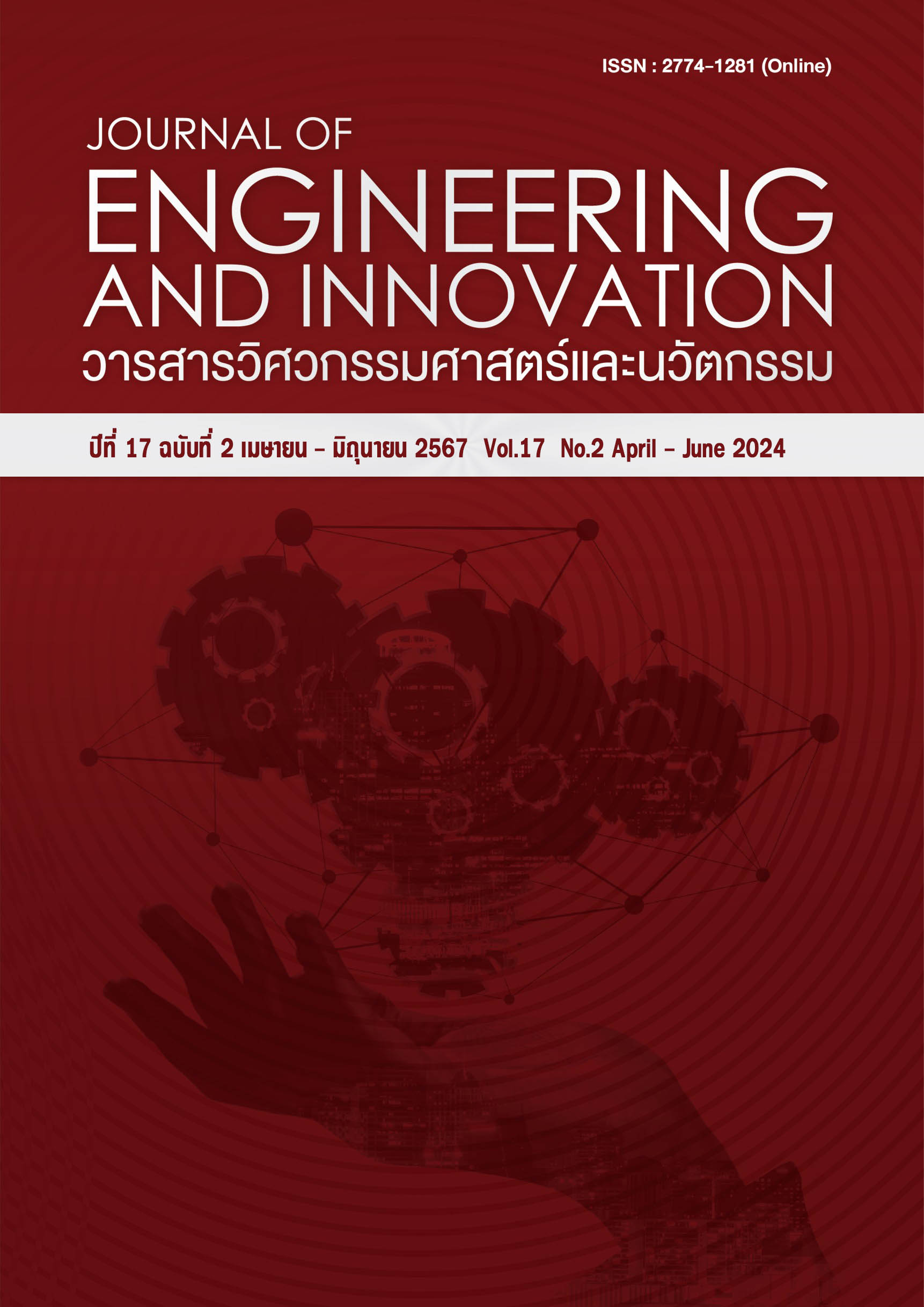Properties of recycled polypropylene has undergone an additive process to produce plastic filament for 3D printers
Main Article Content
Abstract
This research was performed to compare the mechanical and physical properties of polylactic acid plastic strands with fluorescent agent additives with recycled polypropylene plastic strands mixed with polylactid acid, and fluorescent additives for 3D molding process. Three proportions of fluorescent agent additives were used: 0.3%, 0.5% and 1%. The results showed that the tensile strength, modulus of elasticity, percentage of elongation, hardness, flow index, of recycled polypropylene strands mixed with polylactid acid and 0.3% fluorescence agent ratio were optimal, resulting in favorable plastic filaments for 3D printer molding. The addition of large quantities of fluorescent agent resulted in polymer viscosity, which decreased the tensile strength and the flow index of the product. Modulus of elasticity, hardness and elongation percentage were found to have tear characteristics in the tensile test specimen, demonstrating the density characteristics of the molding layer, which corresponded to the elongation percentage. The luster results of all 4 types of plastic strands indicated an excitation wavelength in the 509 nm range, which increased with an increase in the amount of fluorescent agent as a result, the plastic line was shinier. However, the luminosity curves of 0.3%, 0.5% and 1% filling proportions showed that the luminescence proportions were brighter but not significantly different.
Article Details
References
ดารารัตน์ ทาทอง. ผลกระทบจากเทคโนโลยีเครื่องพิมพ์ 3 มิติต้นทุนต่ำต่อการพัฒนาผลิตภัณฑ์ในงานอุตสาหกรรม. ปริญญาวิทยาศาสตรมหาบัณฑิต. สาขาวิชาการบริหารเทคโนโลยี. วิทยาลัยนวัตกรรม มหาวิทยาลัยธรรมศาสตร์, (2559)
ไทยโฮมทาวน์. (2564, 09. 25). ต่อยอดเทคโนโลยี 3D Printing ในวงการก่อสร้างด้วยนวัตกรรม 3D Cement Extrusion Printing. [Online], แหล่งที่มา: https://www.thaihometown.com/
ประชาชาติธุรกิจ. (2564, 11. 25). 3D printing พริกโลกอุตสาหกรรม. [Online], แหล่งที่มา: https://www.prachachat.net/
ณัฏฐนิช ตัณมานะศิริ. (2564, 12. 15). 3D Printing: เทคโนโลยีแห่งโอกาส. [Online], แหล่งที่มา: https://www.i-am-maker.com/
M Report. (2564, 11. 19). 3D Printing: เทคโนโลยีการพิมพ์ 3 มิติ สำหรับอุตสาหกรรมเครื่องจักรกล. [Online], แหล่งที่มา: https://www.mreport.co.th/
วรทร ชูส่งแสง. (2564, 12. 15). 3D Printing: เทคโนโลยีของโลกยุคใหม่. [ระบบออนไลน์], แหล่งที่มา: https://www.petromat.org/
Yang Lu, Meng Jiaguang, XUE Tao. Effect of 3D printing process parameters on tensile strength of PLA specimen [J]. Plastics Industry, 201,49(05):73-77+142.
Makara Lay, Nuur Laila Najwa Thajudin, Zuratul Ain Abdul Hamid, Arjulizan Rusli, Muhammad Khalil Abdullah, Raa Khimi Shuib. Comparison of physical and mechanical properties of PLA, ABS nylon 6 fabricated using fused deposition modeling[J] Composites Part B,2019,176(C).
Shen Liang. Preparation and Research of Polylactic Acid Composite Material for Ecological Vehicle [D]. Jilin University,2021.
A. Ebrahimzade. Study on characteristics and afterglow properties of luminous . ปีที่ (10) : 8167, 2017.
Stefani, R. Rodrigues, L., C., V., Carvalho, C., A., A., Felinto, M., C., F., C., Brito, H., F., and Lastusaari, M., J., H., (2009). “Persistent luminescence of Eu2+ and Dy3+ doped barium aluminate (BaAl2O4:Eu2+, Dy3+) materials”, Opt. Mater. 31, 1815– 1818.
Xiao, L., Meng, S., Junying, Z., and Tianm, W., (2010). “Effect of mixing process on the luminescent properties of SrAl2O4:Eu2+, Dy3+ long afterglow phosphors”, J. Rare Earth., vol. 28, no. 1, Feb. pp.150.
พิชญ์ ดนู ธวัชพันธุ. ผลของสารเรืองแสงต่อการเรืองแสงและความแข็งของยางที่ผลิตจากน้ำยาง คอมปาวด์. การประชุมเสนอผลงานวิจัยระดับชาติ มหาวิทยาลัย สุโขทัยธรรมาธิราช ครั้งที่ 7. 24/11/2560. ณ อาคารเฉลิมพระเกียรติ 80 พรรษา : 1.
Thanyalak Khwankaew, Wuttipong Nilpanan, Supatthra Muparang , Amornsak Mayai, Wannisa Nutkhum and Jittiwat Nitthikarnjanatharn. Plastic Strand Production with Recycled Polypropylene and Polylactic Acid for 3D Molding Processes. The 6th Rajamangala and Management Technology Conference 2021
Ratchapat Sartsoongnern Jittiwat Nitthikarnjanatharn. Study of melting temperature , feed rate and temperature used in 3D printing with Polypropylene Used in the Fused Deposition Modeling process. academic conference Engineering Science Technology and Architecture 9th. September 7, 2018 at 50th Anniversary Thai-German Technical Building, Khon Kaen (Building 18), Faculty of Engineering Rajamangala University of Technology Isan Khon Kaen Campus, Khon Kaen Province
จิตติวัฒน์ นิธิกาญจนธาร และสุภัทรา หมู่ป่ารัง. ส่วนผสมการผลิตเส้นสำหรับการพิมพ์ขึ้นรูป 3 มิติ. กรมทรัพย์สินทางปัญญา. อนุสิทธิบัตรเลขที่ 2303000987
Iulian Antoniac, Diana Popescu, Aurelian Zapciu, Aurora Antoniac, Florin Miculescu, and Horatiu Moldovan. Magnesium Filled Polylactic Acid (PLA) Material for Filament Based 3D Printing. Materials 2019 9, 12, 719.1 March 2019
Ayman M. M. Abdelhaleem. Mechanical Properties of Recycled Polypropylene Mixed with Glass Fibers. International Journal of Advanced Materials Research Vol. 2, No. 4, 2016, pp. 72-79
Rossella Arrigo, Daniele Battegazzore, Giulia Bernagozzi, Fulvia Cravero, David Norberto Ribero Pedraza and Alberto Frache. Recycled PP for 3D Printing: Material and Processing Optimization through Design of Experiment. Appl. Sci. 2022, 12, 10840.
Binglong Li. Meng Zhang, Qunshan Lu, Baoqing Zhang, Zhuang Miao, Lei Li, Tong Zheng, and Peilai Liu. Application and Development of Modern 3D Printing Technology in the Field of Orthopedics. BioMed Research International. Volume 2022, Article ID 8759060, 15 pages
Wantanee Buggakupta. Glowing Ceramic. Ceramics Jounal Vol.14, NO.34, May - August 2010, pp.72-75
